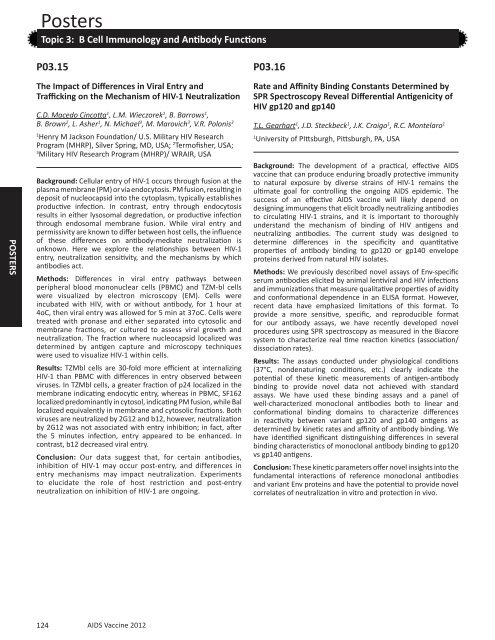Oral Abstract Session 01 - Global HIV Vaccine Enterprise
Oral Abstract Session 01 - Global HIV Vaccine Enterprise
Oral Abstract Session 01 - Global HIV Vaccine Enterprise
You also want an ePaper? Increase the reach of your titles
YUMPU automatically turns print PDFs into web optimized ePapers that Google loves.
POSTERS<br />
Posters<br />
Topic 3: B Cell Immunology and Antibody Functions<br />
P03.15<br />
The Impact of Differences in Viral Entry and<br />
Trafficking on the Mechanism of <strong>HIV</strong>-1 Neutralization<br />
C.D. Macedo Cincotta 1 , L.M. Wieczorek 1 , B. Barrows 1 ,<br />
B. Brown 2 , L. Asher 1 , N. Michael 3 , M. Marovich 3 , V.R. Polonis 3<br />
1 Henry M Jackson Foundation/ U.S. Military <strong>HIV</strong> Research<br />
Program (MHRP), Silver Spring, MD, USA; 2 Termofisher, USA;<br />
3 Military <strong>HIV</strong> Research Program (MHRP)/ WRAIR, USA<br />
Background: Cellular entry of <strong>HIV</strong>-1 occurs through fusion at the<br />
plasma membrane (PM) or via endocytosis. PM fusion, resulting in<br />
deposit of nucleocapsid into the cytoplasm, typically establishes<br />
productive infection. In contrast, entry through endocytosis<br />
results in either lysosomal degredation, or productive infection<br />
through endosomal membrane fusion. While viral entry and<br />
permissivity are known to differ between host cells, the influence<br />
of these differences on antibody-mediate neutralization is<br />
unknown. Here we explore the relationships between <strong>HIV</strong>-1<br />
entry, neutralization sensitivity, and the mechanisms by which<br />
antibodies act.<br />
Methods: Differences in viral entry pathways between<br />
peripheral blood mononuclear cells (PBMC) and TZM-bl cells<br />
were visualized by electron microscopy (EM). Cells were<br />
incubated with <strong>HIV</strong>, with or without antibody, for 1 hour at<br />
4oC, then viral entry was allowed for 5 min at 37oC. Cells were<br />
treated with pronase and either separated into cytosolic and<br />
membrane fractions, or cultured to assess viral growth and<br />
neutralization. The fraction where nucleocapsid localized was<br />
determined by antigen capture and microscopy techniques<br />
were used to visualize <strong>HIV</strong>-1 within cells.<br />
Results: TZMbl cells are 30-fold more efficient at internalizing<br />
<strong>HIV</strong>-1 than PBMC with differences in entry observed between<br />
viruses. In TZMbl cells, a greater fraction of p24 localized in the<br />
membrane indicating endocytic entry, whereas in PBMC, SF162<br />
localized predominantly in cytosol, indicating PM fusion, while Bal<br />
localized equivalently in membrane and cytosolic fractions. Both<br />
viruses are neutralized by 2G12 and b12, however, neutralization<br />
by 2G12 was not associated with entry inhibition; in fact, after<br />
the 5 minutes infection, entry appeared to be enhanced. In<br />
contrast, b12 decreased viral entry.<br />
Conclusion: Our data suggest that, for certain antibodies,<br />
inhibition of <strong>HIV</strong>-1 may occur post-entry, and differences in<br />
entry mechanisms may impact neutralization. Experiments<br />
to elucidate the role of host restriction and post-entry<br />
neutralization on inhibition of <strong>HIV</strong>-1 are ongoing.<br />
124<br />
AIDS <strong>Vaccine</strong> 2<strong>01</strong>2<br />
P03.16<br />
Rate and Affinity Binding Constants Determined by<br />
SPR Spectroscopy Reveal Differential Antigenicity of<br />
<strong>HIV</strong> gp120 and gp140<br />
T.L. Gearhart 1 , J.D. Steckbeck 1 , J.K. Craigo 1 , R.C. Montelaro 1<br />
1 University of PIttsburgh, Pittsburgh, PA, USA<br />
Background: The development of a practical, effective AIDS<br />
vaccine that can produce enduring broadly protective immunity<br />
to natural exposure by diverse strains of <strong>HIV</strong>-1 remains the<br />
ultimate goal for controlling the ongoing AIDS epidemic. The<br />
success of an effective AIDS vaccine will likely depend on<br />
designing immunogens that elicit broadly neutralizing antibodies<br />
to circulating <strong>HIV</strong>-1 strains, and it is important to thoroughly<br />
understand the mechanism of binding of <strong>HIV</strong> antigens and<br />
neutralizing antibodies. The current study was designed to<br />
determine differences in the specificity and quantitative<br />
properties of antibody binding to gp120 or gp140 envelope<br />
proteins derived from natural <strong>HIV</strong> isolates.<br />
Methods: We previously described novel assays of Env-specific<br />
serum antibodies elicited by animal lentiviral and <strong>HIV</strong> infections<br />
and immunizations that measure qualitative properties of avidity<br />
and conformational dependence in an ELISA format. However,<br />
recent data have emphasized limitations of this format. To<br />
provide a more sensitive, specific, and reproducible format<br />
for our antibody assays, we have recently developed novel<br />
procedures using SPR spectroscopy as measured in the Biacore<br />
system to characterize real time reaction kinetics (association/<br />
dissociation rates).<br />
Results: The assays conducted under physiological conditions<br />
(37°C, nondenaturing conditions, etc.) clearly indicate the<br />
potential of these kinetic measurements of antigen-antibody<br />
binding to provide novel data not achieved with standard<br />
assays. We have used these binding assays and a panel of<br />
well-characterized monoclonal antibodies both to linear and<br />
conformational binding domains to characterize differences<br />
in reactivity between variant gp120 and gp140 antigens as<br />
determined by kinetic rates and affinity of antibody binding. We<br />
have identified significant distinguishing differences in several<br />
binding characteristics of monoclonal antibody binding to gp120<br />
vs gp140 antigens.<br />
Conclusion: These kinetic parameters offer novel insights into the<br />
fundamental interactions of reference monoclonal antibodies<br />
and variant Env proteins and have the potential to provide novel<br />
correlates of neutralization in vitro and protection in vivo.


